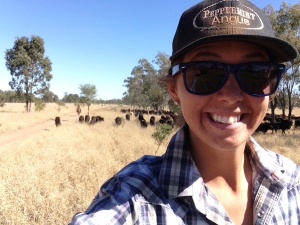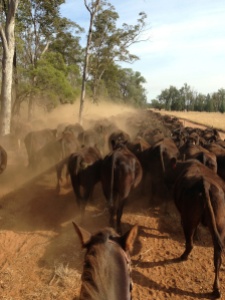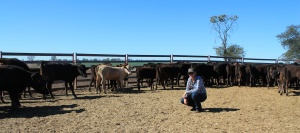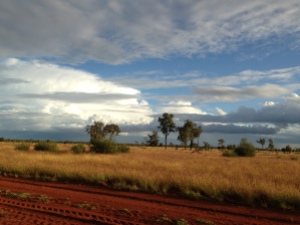Montana Young Stockgrower Spends Summer Down Under
Written by Kelsey Haughian
Gidday all! I am Kelsey Haughian, a senior animal science student at Montana State University, who has recently returned to Montana after 3 months on a remote cattle station in South Central Queensland, Australia. I was asked to give a little break down of my internship and experience down under!
I interned with Australian Agriculture Company (AACo), a company that is on its way to becoming fully integrated in the beef industry (from breeding/genetics to feedlots to slaughter facilities). AACo owns about 600,000 cattle across wide areas of Australia‘s Queensland and Northern Territory. The property I was at, Wylarah Station, is the breeding and genetics base for AACo. They operate on 30,300 hectares (about 117 sections) with a carrying capacity of 7,000 head on 550mm (22 inches) of rain a year.
I had the opportunity to work with the world’s largest herd of Wagyu cattle as well as elite Brahman/Santa Gertrudis/Bonsmara/Senepol/Charolais composite herds owned by AACo. The Wagyu stud herd (female sires) are now the largest herd of Wagyu in the world and produce offspring for AACo’s branded beef product that is sold mostly to Japan. This beef is very unique as the feeder cattle are on feed anywhere from 400 to 700 days! This length of time is for adequate marbling and growth time for the best quality of Wagyu. These cattle are fattened at one of the company’s feedlots (I had the opportunity to visit it during my stay and it is quite impressive!). At my station (Aussie term for ranch), we had about 2,000 Wagyu studs that were monitored like any registered herd in the US records on performance are highly extensive!
The elite Composite herds at the station have been closely monitored for economically important traits (high fertility, adaptability, fast growth, feed conversion efficiency, as well as carcass traits) to increase efficiency and productivity of the company. My station provides the base genetics of Composites for the larger stations in the northern region of Australia, including bulls and replacement heifers to keep optimal levels of each breed within the Composite breeds itself.
One of the most unique aspects of the my internship was the actual handling of cattle. As is well known, cattle have distinct flight zones, and a good grasp on these zones makes for easier, more efficient processing/gathering/etc. Wylarah hires a contractor who specializes in “breaking” cattle; “teaching” them to work with people, horses, and dogs as well as process through yards (known as corrals to us!). The contractor works with the newly weaned calves for a couple weeks. The idea behind this “breaking” is to increase efficiency and decrease stress. If the cattle are relaxed and stress free, performance is increased. It is also used on the genetic side; to cull the flighty and keep the calm cattle, which is important with the large scale of the company. The low stress handling was a constant learning experience for me; the cattle work for you, you don’t work for them. I will miss mustering(also known as gathering) with a couple packs of dogs!
I can’t say enough how exhilarating this “holiday” was for me! The personal growth and cultural experience was just as beneficial as the livestock experience. I can’t express how thankful I am to the Wylarah Station staff who accepted me as one of the “family.” This internship would not have been possible if it wasn’t for the financial assistance from scholarships, grants, and family. MSU’s Exc.e.ed Grant helped tremendously with airfare and transportation; I am very appreciative to receive their financial assistance to fulfill a life long dream. I have so many stories and experiences to share, so feel free to contact me with questions!
Call it an internship, working holiday, or an experience of a lifetime…either way, I had the most amazing opportunity in Australia on a working cattle station!






Tamara Beardsley Choat
Nice writing Kelsey! What a great experience!
11:59 am - September 4, 2014